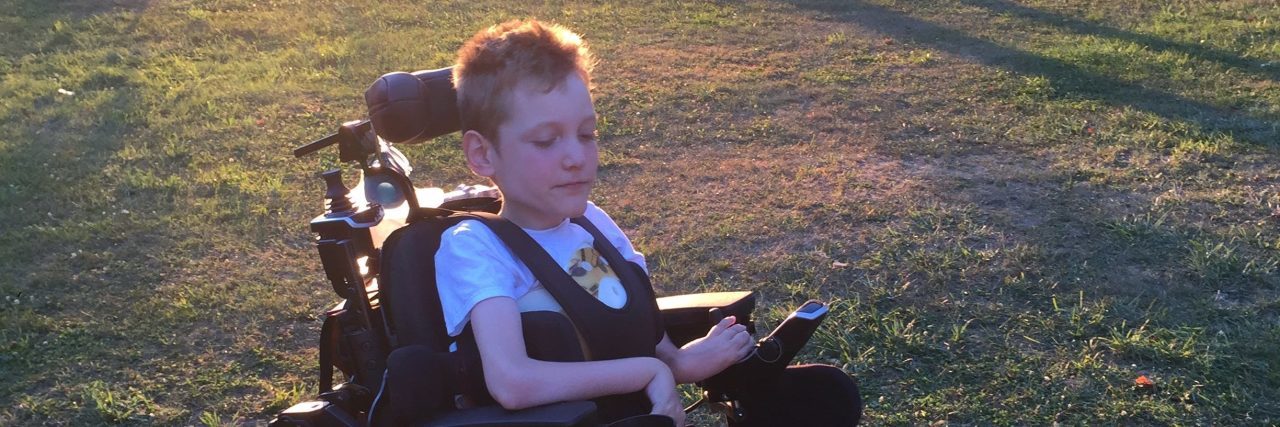I received an email from an old friend whose child was going to be meeting my two youngest sons for the first time. Her child didn’t know anyone else in a wheelchair and she wanted to know how to prepare him to meet my two sons who have spinal muscular atrophy, and use powerchairs for mobility. She didn’t want him to say anything rude or stare. She wondered if she should check books out of the library, buy a doll in a wheelchair, do some play acting, or run through a litany of potential situations and what he should say. While I was very impressed with all her ideas, I quickly insisted that building up the meeting was a last minute effort. Here’s a bit of what I did share, along with some other tips.
1. Make disabled kids and adults a regular part of your child’s world now.
More and more shows for children and adults include characters with disabilities. You don’t need to point out every instance of a person in a wheelchair, but just make sure these shows are part of your child’s regular viewing. Also, pick up a few books about disabilities on your next library run. (Some ideas.) You don’t need to make a big deal about it, just read the story and follow your child’s lead. If they ask questions, answer them, and if you don’t know how, look it up! Don’t be afraid to say the name of a diagnosis. All my kids want is to be viewed as “normal.” You make that possible but exposing your child to disabled adults and kids as much as possible.
2. If you’re not sure how they’ll respond when meeting a disabled person for the first time, mention the upcoming get together and show a picture of who you’re visiting.
Then answer your child’s questions as they arise. “Why does that child in the picture use a wheelchair?” Don’t make a big deal of it, just answer his questions. You can also share other facts about whomever it is you’re visiting. “Yes, my friend’s son uses a wheelchair, but look at his T-shirt, he likes Marvel just like you. And see the Minecraft logo on his hat? You love that game, too. I bet he would love to talk to you about that.”
3. Watch your words.
Avoid saying something is “wrong” or “not normal.” Disabled children are not typical but their life is completely “normal” to them. And their disability isn’t “wrong” or an indication that they’re “sick.” It’s just who they are. Your child may express sadness that a disabled person can’t do something (walk, see, talk, etc.) Stress that the disabled person or child’s life isn’t sad, and he or she doesn’t feel sad all the time because of his or her disability. Disabled children and adults also aren’t inspirational or heroes just for existing and doing normal things. Your child doesn’t need to celebrate or praise everything my child does. Avoid saying words like “strong,” “courageous,” “brave” or “heroic” unless my child has just won an Olympic medal or climbed Mt. Everest.
4. Model good behavior.
Your child will follow your example. If you tell your child to be friendly and treat my child like any other child, but then come over and pat my 10-year-old on the head and talk down to him like he’s a baby, your child will assume the same attitude.
5. Make sure your child knows he doesn’t have to become my son’s best friend or helper.
You child also doesn’t have to do everything my son wants just because my son is disabled. If my son is being bossy and mean, it’s OK to not play with him. And if my son needs help but is rude about asking, you child can wait for him to use his manners (like I insist of all my children). My disabled kids sometimes need help, but they are not spoiled or babied.
6. Wheelchairs and medical equipment make a disabled child or adult more independent.
Your child doesn’t need to focus on the chair, but let them know it’s something to be happy about, not a reason to pity someone. And they can’t touch it! Never ever! It’s not a toy, like, the best Powerwheels ever, or something. It’s an extension of the person using it. If your child doesn’t like strangers touching him, he shouldn’t touch the medical device of someone else. Even service animals are off-limits, no matter how cute and cuddly.
7. If you want to spread awareness to a group of kids (scouts, club, classroom) use reliable resources created by disabled adults.
Having a group of teens take turns in a wheelchair doesn’t mean they now know what it’s like to spend life in a wheelchair. They just might have a better idea of how the building they’re in is not accessible. They need to hear from disabled people about the challenges and joys they face, not what able-bodied people think life with a disability looks like.
Embarrassing comments and stares may still happen: don’t stress about it! The more your child becomes used to being around disabled children and adults, the less out of the ordinary it will seem to them.

